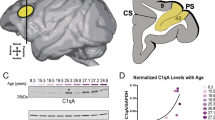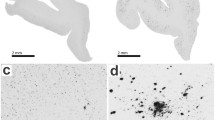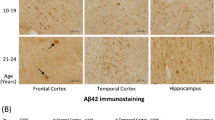Abstract
Loss of synaptic integrity in the hippocampus and prefrontal cortex (PFC) may play an integral role in age-related cognitive decline. Previously, we showed age-related increases in the dendritic marker microtubule associated protein 2 (MAP-2) and the synaptic marker synaptophysin (SYN) in mice. Similarly, apolipoprotein E (apoE), involved in lipid transport and metabolism, and glial fibrillary acidic protein (GFAP), a glia specific marker, increase with age in rodents. In this study, we assessed whether these four proteins show similar age-related changes in a nonhuman primate, the rhesus macaque. Free-floating sections from the PFC and hippocampus from adult, middle-aged, and aged rhesus macaques were immunohistochemically labeled for MAP-2, SYN, apoE, and GFAP. Protein levels were measured as area occupied by fluorescence using confocal microscopy as well as by Western blot. In the PFC and hippocampus of adult and middle-aged animals, the levels of SYN, apoE, and GFAP immunoreactivity were comparable but there was a trend towards higher MAP-2 levels in middle-aged than adult animals. There was significantly less SYN and more MAP-2, apoE, and GFAP immunoreactivity in the PFC and hippocampus of aged animals compared to adult or middle-aged animals. Thus, the age-related changes in MAP-2, apoE, and GFAP levels were similar to those previously observed in rodents. On the other hand, the age-related changes in SYN levels were not, but were similar to those previously observed in the aging human brain. Taken together, these data emphasize the value of the rhesus macaque as a pragmatic translational model for human brain aging.










Similar content being viewed by others
References
Adams MM, Shi L, Linville MC, Forbes ME, Long AB, Bennett C, Newton IG, Carter CS, Sonntag WE, Riddle DR, Brunso-Bechtold JK (2008) Caloric restriction and age affect synaptic proteins in hippocampal CA3 and spatial learning ability. Exp Neurol 211:141–149
Albert MS, Moss MB (1999) Cognitive profiles of normal human aging. In: Peters A, Morrison JH (eds) Cerebral cortexCerebral cortex. Kluwer/Plenum, New York, pp 1–20
Benice TS, Rizk A, Kohama S, Pfankuch T, Raber J (2006) Sex-differences in age-related cognitive decline in C57BL/6 J mice associated with increased brain microtubule-associated protein 2 and synaptophysin immunoreactivity. Neuroscience 137:413–423
Berciano MT, Andres MA, Calle E, Lafarga M (1995) Age-induced hypertrophy of astrocytes in rat supraoptic nucleus: a cytological, morphometric, and immunocytochemical study. Anat Rec 243:129–144
Bjorklund H, Eriksdotter-Nilsson M, Dahl D, Rose G, Hoffer B, Olson L (1985) Image analysis of GFA-positive astrocytes from adolescence to senescence. Exp Brain Res 58:163–170
Burns MP, Noble WJ, Olm V, Gaynor K, Casey E, LaFrancois J, Wang L, Duff K (2003) Co-localization of cholesterol, apolipoprotein E and fibrillar Abeta in amyloid plaques. Brain Res Mol Brain Res 110:119–125
Calhoun ME, Kurth D, Phinney AL, Long JM, Hengemihle J, Mouton PR, Ingram DK, Jucker M (1998) Hippocampal neuron and synaptophysin-positive bouton number in aging C57BL/6 mice. Neurobiol Aging 19:599–606
Chauhan N, Siegel G (1997) Age-dependent organotypic expression of microtubule-associated proteins (MAP1, MAP2, and MAP5) in rat brain. Neurochem Res 22:713–719
Cork LC, Masters C, Beyreuther K, Price DL (1990) Development of senile plaques. Relationships of neuronal abnormalities and amyloid deposits. Am J Pathol 137:1383–1392
Dawson GR, Seabrook GR, Zheng H, Smith DW, Graham S, O’Dowd G, Bowery BJ, Boyce S, Trumbauer ME, Chen HY, Van der Ploeg LH, Sirinathsinghji DJ (1999) Age-related cognitive deficits, impaired long-term potentiation and reduction in synaptic marker density in mice lacking the beta-amyloid precursor protein. Neuroscience 90:1–13
Di Stefano G, Casoli T, Fattoretti P, Gracciotti N, Solazzi M, Bertoni-Freddari C (2001) Distribution of map2 in hippocampus and cerebellum of young and old rats by quantitative immunohistochemistry. J Histochem Cytochem 49:1065–1066
Eastwood SL, Weickert CS, Webster MJ, Herman MM, Kleinman JE, Harrison PJ (2006) Synaptophysin protein and mRNA expression in the human hippocampal formation from birth to old age. Hippocampus 16:645–654
Fukuda T, Shimizu J, Furuhata H, Abe T, Shimizu K, Oishi T, Ogihara M, Kubota J, Sasaki A, Sasaki K, Azuma T, Umemura S (2005) Overexpression of heat shock proteins in pallido-nigral axonal spheroids of nonhuman aged primates. Acta Neuropathol 110:145–150
Gallardo G, Schluter OM, Sudhof TC (2008) A molecular pathway of neurodegeneration linking alpha-synuclein to ApoE and Abeta peptides. Nat Neurosci 11:301–308
Garcia-Segura LM, Chowen JA, Duenas M, Parducz A, Naftolin F (1996) Gonadal steroids and astroglial plasticity. Cell Mol Neurobiol 16:225–237
Garcia-Segura LM, Chowen JA, Duenas M, Torres-Aleman I, Naftolin F (1994a) Gonadal steroids as promoters of neuro-glial plasticity. Psychoneuroendocrinology 19:445–453
Garcia-Segura LM, Luquin S, Parducz A, Naftolin F (1994b) Gonadal hormone regulation of glial fibrillary acidic protein immunoreactivity and glial ultrastructure in the rat neuroendocrine hypothalamus. Glia 10:59–69
Gearing M, Rebeck GW, Hyman BT, Tigges J, Mirra SS (1994) Neuropathology and apolipoprotein E profile of aged chimpanzees: implications for Alzheimer disease. Proc Natl Acad Sci USA 91:9382–9386
Geinisman Y, Detoledo-Morrell L, Morrell F, Heller RE (1995) Hippocampal markers of age-related memory dysfunction: behavioral, electrophysiological and morphological perspectives. Prog Neurobiol 45:223–252
Gosche KM, Mortimer JA, Smith CD, Markesbery WR, Snowdon DA (2002) Hippocampal volume as an index of Alzheimer neuropathology: findings from the Nun Study. Neurology 58:1476–1482
Harada A, Teng J, Takei Y, Oguchi K, Hirokawa N (2002) MAP2 is required for dendrite elongation, PKA anchoring in dendrites, and proper PKA signal transduction. J Cell Biol 158:541–549
Hartig W, Bruckner G, Schmidt C, Brauer K, Bodewitz G, Turner JD, Bigl V (1997) Co-localization of beta-amyloid peptides, apolipoprotein E and glial markers in senile plaques in the prefrontal cortex of old rhesus monkeys. Brain Res 751:315–322
Hatters DM, Peters-Libeu CA, Weisgraber KH (2006) Apolipoprotein E structure: insights into function. Trends Biochem Sci 31:445–454
Hesse C, Bogdanovic N, Davidsson P, Blennow K (1999) A quantitative and immunohistochemical study on apolipoprotein E in brain tissue in Alzheimer’s disease. Dement Geriatr Cogn Disord 10:452–459
Himeda T, Mizuno K, Kato H, Araki T (2005) Effects of age on immunohistochemical changes in the mouse hippocampus. Mech Ageing Dev 126:673–677
Hol EM, Roelofs RF, Moraal E, Sonnemans MA, Sluijs JA, Proper EA, de Graan PN, Fischer DF, van Leeuwen FW (2003) Neuronal expression of GFAP in patients with Alzheimer pathology and identification of novel GFAP splice forms. Mol Psychiatry 8:786–796
Kadish I, Thibault O, Blalock EM, Chen KC, Gant JC, Porter NM, Landfield PW (2009) Hippocampal and cognitive aging across the lifespan: a bioenergetic shift precedes and increased cholesterol trafficking parallels memory impairment. J Neurosci 29:1805–1816
Keuker JI, Luiten PG, Fuchs E (2003) Preservation of hippocampal neuron numbers in aged rhesus monkeys. Neurobiol Aging 24:157–165
Kohama SG, Goss JR, Finch CE, McNeill TH (1995) Increases of glial fibrillary acidic protein in the aging female mouse brain. Neurobiol Aging 16:59–67
Landfield PW, Rose G, Sandles L, Wohlstadter TC, Lynch G (1977) Patterns of astroglial hypertrophy and neuronal degeneration in the hippocampus of ages, memory-deficient rats. J Gerontol 32:3–12
Levy R, Goldman-Rakic P (1999) Association of storage and processing functions in the dorsolateral prefrontal cortex of the non-human primate. J Neurosci 19:5149–5158
Lindsey JD, Landfield PW, Lynch G (1979) Early onset and topographical distribution of hypertrophied astrocytes in hippocampus of aging rats: a quantitative study. J Gerontol 34:661–671
Liu X, Erikson C, Brun A (1996) Cortical synaptic changes and gliosis in normal aging, Alzheimer's disease and frontal lobe degeneration. Dementia 7:128–134
Maguire EA, Cipolotti L (1998) Selective sparing of topographical memory. J Neurol Neurosurg Psychiatry 65:903–909
Masliah E, Mallory M, Hansen L, DeTeresa R, Terry RD (1993) Quantitative synaptic alterations in the human neocortex during normal aging. Neurology 43:192–197
Merrill DA, Roberts JA, Tuszynski MH (2000) Conservation of neuron number and size in entorhinal cortex layers II, III, and V/VI of aged primates. J Comp Neurol 422:396–401
Minkeviciene R, Ihalainen J, Malm T, Matilainen O, Keksa-Goldsteine V, Goldsteins G, Iivonen H, Leguit N, Glennon J, Koistinaho J, Banerjee P, Tanila H (2008) Age-related decrease in stimulated glutamate release and vesicular glutamate transporters in APP/PS1 transgenic and wild-type mice. J Neurochem 105:584–594
Morelli L, Wei L, Amorim A, McDermid J, Abee CR, Frangione B, Walker LC, Levy E (1996) Cerebrovascular amyloidosis in squirrel monkeys and rhesus monkeys: apolipoprotein E genotype. FEBS Lett 379:132–134
Moss MB, Killiany RJ, Herndon JG (1999) Age-related cognitive decline in the rhesus monkey. In: Peters A, Morrison JH (eds) Cerebral cortexCerebral cortex. Kluwer/Plenum, New York, pp 21–48
Mufson EJ, Benzing WC, Cole GM, Wang H, Emerich DF, Sladek JR Jr, Morrison JH, Kordower JH (1994) Apolipoprotein E-immunoreactivity in aged rhesus monkey cortex: colocalization with amyloid plaques. Neurobiol Aging 15:621–627
Mukaetova-Ladinska EB, Garcia-Siera F, Hurt J, Gertz HJ, Xuereb JH, Hills R, Brayne C, Huppert FA, Paykel ES, McGee M, Jakes R, Honer WG, Harrington CR, Wischik CM (2000) Staging of cytoskeletal and beta-amyloid changes in human isocortex reveals biphasic synaptic protein response during progression of Alzheimer’s disease. Am J Pathol 157:623–636
Mulder M, Jansen PJ, Janssen BJ, van de Berg WD, van der Boom H, Havekes LM, de Kloet RE, Ramaekers FC, Blokland A (2004) Low-density lipoprotein receptor-knockout mice display impaired spatial memory associated with a decreased synaptic density in the hippocampus. Neurobiol Dis 16:212–219
Nakamura S, Kiatipattanasakul W, Nakayama H, Ono F, Sakakibara I, Yoshikawa Y, Goto N, Doi K (1996) Immunohistochemical characteristics of the constituents of senile plaques and amyloid angiopathy in aged cynomolgus monkeys. J Med Primatol 25:294–300
Nichols NR, Day JR, Laping NJ, Johnson SA, Finch CE (1993) GFAP mRNA increases with age in rat and human brain. Neurobiol Aging 14:421–429
Nishiyama E, Iwamoto N, Ohwada J, Arai H (1997) Distribution of apolipoprotein E in senile plaques in brains with Alzheimer’s disease: investigation with the confocal laser scan microscope. Brain Res 750:20–24
Overmyer M, Helisalmi S, Soininen H, Laakso M, Riekkinen P Sr, Alafuzoff I (1999) Astrogliosis and the ApoE genotype. An immunohistochemical study of postmortem human brain tissue. Dement Geriatr Cogn Disord 10:252–257
Paulesu E, Frith C, Frackowiak R (1993) The neural correlates of the verbal component of working memory. Nature 362:342–345
Peister A, Zeitouni S, Pfankuch T, Reger RL, Prockop DJ, Raber J (2006) Novel object recognition in Apoe(-/-) mice improved by neonatal implantation of wild-type multipotential stromal cells. Exp Neurol 201:266–269
Petanceska SS, DeRosa S, Sharma A, Diaz N, Duff K, Tint SG, Refolo LM, Pappolla M (2003) Changes in apolipoprotein E expression in response to dietary and pharmacological modulation of cholesterol. J Mol Neurosci 20:395–406
Peters A, Sethares C (2002) The effects of age on the cells in layer 1 of primate cerebral cortex. Cereb Cortex 12:27–36
Poduri A, Gearing M, Rebeck GW, Mirra SS, Tigges J, Hyman BT (1994) Apolipoprotein E4 and beta amyloid in senile plaques and cerebral blood vessels of aged rhesus monkeys. Am J Pathol 144:1183–1187
Poirier J (1994) Apolipoprotein E in animal models of CNS injury and in Alzheimer’s disease. Trends Neurosci 17:525–530
Poirier J (2000) Apolipoprotein E and Alzheimer’s disease. A role in amyloid catabolism. Ann N Y Acad Sci 924:81–90
Prieto-Gomez B, Velazquez-Paniagua M, Cisneros LO, Reyes-Vazquez C, Jimenez-Trejo F, Reyes ME, Mendoza-Torreblanca J, Gutierrez-Ospina G (2008) Melatonin attenuates the decrement of dendritic protein MAP-2 immuno-staining in the hippocampal CA1 and CA3 fields of the aging male rat. Neurosci Lett 448:56–61
Rapp PR, Amaral DG (1991) Recognition memory deficits in a subpopulation of aged monkeys resemble the effects of medial temporal lobe damage. Neurobiol Aging 12:481–486
Rapp PR, Gallagher M (1996) Preserved neuron number in the hippocampus of aged rats with spatial learning deficits. PNAS 93:9926–9930
Rapp PR, Heindel WC (1994) Memory systems in normal and patholigical aging. Curr Opin Neurol 7:294–298
Rapp PR, Kansky MT, Roberts JA (1997) Impaired spatial information processing in aged monkeys with preserved recognition memory. NeuroReport 8:1923–1928
Rosenbaum RS, Winocur G, Moscovitch M (2001) New views on old memories: Re-evaluating the role of the hippocampal complex. Behavioral Brain Research 127:183–197
Sandell JH, Peters A (2002) Effects of age on the glial cells in the rhesus monkey optic nerve. J Comp Neurol 445:13–28
Sani S, Traul D, Klink A, Niaraki N, Gonzalo-Ruiz A, Wu CK, Geula C (2003) Distribution, progression and chemical composition of cortical amyloid-beta deposits in aged rhesus monkeys: similarities to the human. Acta Neuropathol 105:145–156
Shapiro LA, Whitaker-Azmitia PM (2004) Expression levels of cytoskeletal proteins indicate pathological aging of S100B transgenic mice: an immunohistochemical study of MAP-2, drebrin and GAP-43. Brain Res 1019:39–46
Si X, Miguel-Hidalgo JJ, O'Dwyer G, Stockmeier CA, Rajkowska G (2004) Age-dependent reductions in the level of glial fibrillary acidic protein in the prefrontal cortex in major depression. Neuropsychopharmacology 29:2088–2096
Sloane JA, Hollander W, Rosene DL, Moss MB, Kemper T, Abraham CR (2000) Astrocytic hypertrophy and altered GFAP degradation with age in subcortical white matter of the rhesus monkey. Brain Res 862:1–10
Struble RG, Afridi S, Beckman-Randall S, Li M, Cady C, Nathan B, McAsey ME (2006) Neocortical and hippocampal glial fibrillary acidic protein immunoreactivity shows region-specific variation during the mouse estrous cycle. Neuroendocrinology 83:325–335
Tarsa L, Goda Y (2002) Synaptophysin regulates activity-dependent synapse formation in cultured hippocampal neurons. Proc Natl Acad Sci USA 99:1012–1016
Uno H, Alsum PB, Dong S, Richardson R, Zimbric ML, Thieme CS, Houser WD (1996) Cerebral amyloid angiopathy and plaques, and visceral amyloidosis in aged macaques. Neurobiol Aging 17:275–281
Winocur G, Gagnon S (1998) Glucose treatment attenuates spatial learning and memory deficits of aged rats on tests of hippocampal function. Neurobiol Aging 19:233–241
Zyzak DR, Otto T, Eichenbaum H, Gallagher M (1995) Cognitive decline associated with normal aging in rats: a neuropsychological approach. Learn Mem 2:1–16
Acknowledgements
The authors would like to thank Dominique Eghlidi and Sharon Kryger for their technical assistance. This work was supported by NIH Grants AG-023477, AG-029612, RR-000163, and an OHSU Tartar Fellowship.
Author information
Authors and Affiliations
Corresponding author
About this article
Cite this article
Haley, G.E., Kohama, S.G., Urbanski, H.F. et al. Age-related decreases in SYN levels associated with increases in MAP-2, apoE, and GFAP levels in the rhesus macaque prefrontal cortex and hippocampus. AGE 32, 283–296 (2010). https://doi.org/10.1007/s11357-010-9137-9
Received:
Accepted:
Published:
Issue Date:
DOI: https://doi.org/10.1007/s11357-010-9137-9




